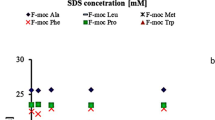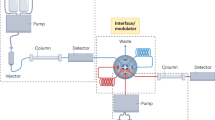Abstract
AN apparatus has been constructed which makes it possible to observe the migration on thin-layer chromatograms of fluorescent compounds and compounds which have a quenching effect on an adsorbent material prepared with a fluorescent indicator. This apparatus, shown in Fig. 1, has been called the Eureka tank, and consists of a moulded glass tank with a lid measuring 23 × 23 × 7.5 cm.
This is a preview of subscription content, access via your institution
Access options
Subscribe to this journal
Receive 51 print issues and online access
$199.00 per year
only $3.90 per issue
Buy this article
- Purchase on Springer Link
- Instant access to full article PDF
Prices may be subject to local taxes which are calculated during checkout
Similar content being viewed by others
References
Kay, H. L., and Warren, F. L., Nature, 203, 406 (1964).
Kay, H. L., and Warren, F. L., J. Chromatog. (in the press).
Shellard, E. J., Laboratory Practice, 13, 290 (1964).
Author information
Authors and Affiliations
Rights and permissions
About this article
Cite this article
KAY, H. Apparatus for Dynamic Thin-layer Chromatography. Nature 209, 1237–1238 (1966). https://doi.org/10.1038/2091237a0
Issue Date:
DOI: https://doi.org/10.1038/2091237a0
Comments
By submitting a comment you agree to abide by our Terms and Community Guidelines. If you find something abusive or that does not comply with our terms or guidelines please flag it as inappropriate.



